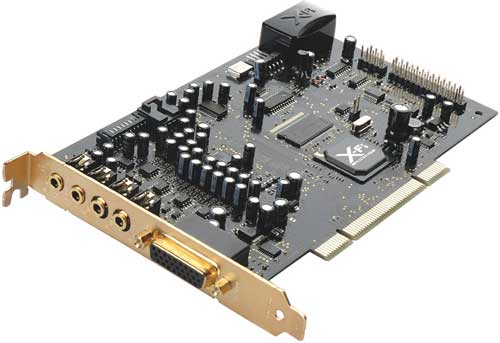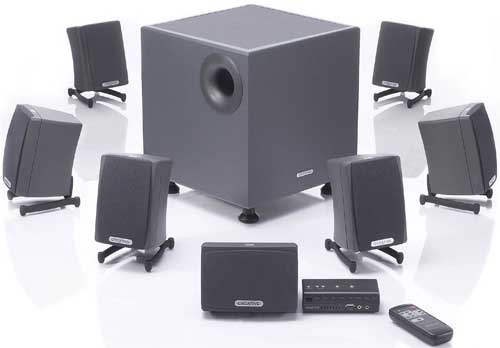The Business of Technology: Creative Labs
by Ryan Smith on October 2, 2007 5:00 PM EST- Posted in
- Bulldozer
Creative's Technology
So what has brought upon these changes in revenue and Creative's overall business problems? The answer to that lies in what's been going on with their technology and individual product market share.
Earlier we called Creative the king of sound cards until recently, much of their business woes stems from that loss. Creative's history is one founded on the back of the Sound Blaster hardware and the Sound Blaster name, creating a problem for Creative in having all of their eggs in one basket that they have been trying to solve for years. All told, Creative hasn't had a lot of luck spreading out their business and doing well; various efforts like graphics cards and DVD-ROM drives never panned out. Of the few things that have panned out, Creative's major consumer product lines have settled in as the following: portable media players, sound cards, webcams, and speakers.
Since sound cards were Creative's biggest business at one point, it has been Creative's biggest loss. Onboard audio has gone from a joke 10 years ago to how the vast majority of computers today handle audio, and it has been Creative who has suffered the greatest losses from that. The Live and Audigy series have both been bonafide successes in terms of sales, but never the less sales are slowing and the X-Fi likely won't be nearly as successful. The fact of the matter is that the consumer sound card market is on its last leg and the possible user base for such hardware has shrunk to professionals and gamers, and that's it.

The X-Fi will likely be the last significant feature-heavy sound DSP to be released by anyone, and it will never match the kinds of sales Creative has seen with earlier products. The final nail in the coffin will be Windows Vista, which as we have discussed in our review of that operating system, under normal circumstances runs the entire audio subsystem in software, reducing the need for a sound card down to a DAC to handle the digital/analog conversion. Creative's own troubles in writing solid Vista drivers for their sound cards hasn't helped matters either, but this has only hastened the inevitable. The sound card is dead, and it isn't coming back.
So what is Creative's leading product with the demise of the sound card? As we saw in their financials, it's now portable media players, a growing market but unfortunately for Creative it's one that they're getting slaughtered in. Prior to the arrival of the iPod, Creative was vying for the top of the portable media player market next to the now-defunct Rio brand, leading to the infamous Slashdot quote about the iPod's release: "No wireless. Less space than a nomad. Lame." Now Creative is struggling in a market where it was one of the first players.

Apple has the vast majority of the North American market for obvious reasons, but #2 tends to be shocking to most people: SanDisk. With Apple's main focus on the mid-to-high end MP3 player market, it has left an opening for cheap media players that SanDisk has been able to fill. Meanwhile both SanDisk and Apple have kept Creative and the other competitors locked out of the market, with Creative taking the #3 spot with less than 4% of the market. Creative's problems are further compounded by Microsoft at #4, who is more than happy to lose money on the media player market for now, and previously backed the PlaysForSure technology that Creative uses for DRM. It should be noted however that Apple doesn't have this kind of penetration in Asia, but as there are no reliable statistics on sales in most Asian markets, we can't ascertain what Creative's exact share there is, but it's believed to still be well below #1.
As a result of all of this, what little share of the market Creative has is almost entirely composed of the near-commodity market, save the small number of "anything but Apple" sales. Their Nomad and Zen lines do not have any significant brand recognition, meanwhile SanDisk can build & sell flash based media players for less than Creative. What little bit of the near-commodity market Creative does have a strong foot in is hard drive based media players that focus on video, and even this is at risk of being undermined by Apple now that they have a full-screen iPod to compete. In spite of all of this the majority of Creative's revenue comes from portable media player sales, but fighting on the near-commodity market means they will never be able to attain much of a profit with it.
Creative's third market segment, webcams, is more or less the same story. Webcams are a commodity - there's a lot of competition and not a lot of money. They may stay in it, but they'll never be able to repeat their most profitable days relying on webcams.
There is one bright spot for Creative however, and that's speakers. In their efforts to branch out Creative picked up Cambridge Soundworks in 1997, and their speaker division has continued to perform well. Creative is only dealing in computer speakers which limits their overall market and they face stiff competition from the likes of Logitech, but this market isn't quite a commodity market like Creative's other major markets. In fact as a percentage of revenue the speaker division is nearly 20%, which is itself nearly twice as much as it was 2 years ago. We'd expect Creative to be pushing their speaker products harder as the sound card market finishes crashing, since even with the integration of audio consumers still need speakers.

Finally there are all of Creative's other markets, which we'll touch on briefly. Creative continues to sell various peripherals, such as mice and routers, but most of these are low-volume products that are simply rebranded products form other suppliers. In fact most readers have probably never seen these products in a local store; Creative's minor product lines are almost exclusively limited to the Asian markets. The profitability from these operations is reportedly decent, but it's not something that Creative can win at in the international markets.










95 Comments
View All Comments
calyth - Tuesday, October 2, 2007 - link
I thought Creative made some great soundcards, until I've suffered from an improperly grounded SB Live (then their flagship sound card). Their mounting bracket was not grounded properly, resulting in one dead SB Live card, one dead SCSI controller, and a non-functional PSU.I found that the Aureal 3D support on the Hercules Fortissimo II gave a much better directional sound in EAX, and had it not been the lack of hardware mixing in Linux for the Hercules sound cards, I wouldn't have gone back to the Audigy 2.
To this day, their support for non-Windows OS is kinda spotty - they release their manuals in .chm, the only computing hardware manufacturer that I know that uses this format instead of PDF. Their flagship X-Fi has only recently got a lousy driver for Linux 64bit. Their MP3 players are nothing to write home about.
I personally can't wait until they're gone.
0roo0roo - Friday, October 12, 2007 - link
yup, i'm glad ms sunk them. they've always been on the wrong side, i used to buy aureal cards which had better technology but sadly they went down. i refused to pay premium for a monopoly on gaming audio, and frankly i didn't really miss out. their technology has been stagnant while they milked gamers with high prices, well the gravy train is at an end. we have cores to spare for audio that can be improved without paying for a new card. win win.sheh - Tuesday, October 2, 2007 - link
CHM documentation? That's the first good thing I hear about Creative in a while.PDF = for printing.
CHM = for active reading or searching.
Try http://xchm.sourceforge.net/">http://xchm.sourceforge.net/ (never used it, but I think it should do).
Missing Ghost - Tuesday, October 2, 2007 - link
I agreed. I really wish that Creative will die, we don't want them.Jodiuh - Tuesday, October 2, 2007 - link
Die Creative. Die. And I've got an X-Fi. :DWo/ it, my GPU would be cooler tho.